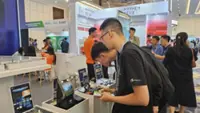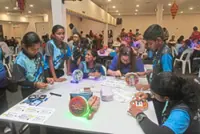With a precise, controlled movement, microrobots clear a glass plate of a biofilm in this time-lapse sequence. — Dr HWANG GEELSU and Dr EDWARD STEAGER
Biofilms – structured communities of microorganisms that create a protective matrix shielding them from external threats, including antibiotics – are responsible for about 80% of human infections and present a significant challenge in medical treatments, often resisting conventional methods.
Dr Michel Koo Hyun of the School of Dental Medicine and Dr Edward Steager of the School of Engineering and Applied Science at the University of Pennsylvania, United States, discuss in this Q&A an innovative approach they’ve partnered on: the use of small-scale robotics, i.e. microrobots, to offer a promising solution to tackle these persistent infections.
Dr Koo: Treating biofilms is a broad, yet unresolved biomedical problem, and conversely, the strategies for tackling biofilms are limited for a number of reasons.
For instance, biofilms typically occur on surfaces that can be tricky to reach, like between the teeth in the oral cavity, the respiratory tract, or even within catheters and implants.
So, treatments for these are usually restricted to antibiotics (or antimicrobials) and other physical methods reliant on mechanical disruption.
However, this touches on the problem of antimicrobial resistance.
Targeting specific microorganisms present in these structures is difficult, so antibiotics often fail to reach and penetrate the biofilm’s protective layers, leading to persistent infections and increased risk of antibiotic resistance.
We needed a way to circumvent these constraints, so Ed and I teamed up in 2017 to develop new, more precise and effective approaches that leverage the engineers’ ability to generate solutions that we, the clinicians and life science researchers, identify.
Dr Steager: Small scale robots present a way to treat, disrupt and remove biofilms by directly targeting the sites of infection, and they also offer new means of retrieving microbial samples and subsequently diagnosing other conditions.
The integration of microrobotics into healthcare signifies a paradigm shift in how we approach medical treatments, promising more efficient and less invasive options.
We’re happy to see that this trend has gained momentum in the last five years since our first publication, driven by technological advancements and interdisciplinary collaborations like ours.
Dr Steager: We typically categorise these robots into two main types: intrinsically powered and extrinsically powered.
The former derive energy from their immediate environment; this can include chemical energy, biological processes or ambient energy sources, and even from tiny internal engineered power sources.
They offer greater autonomy and can operate in various environments, but their independent movement can be challenging to control precisely.
On the other hand, we have extrinsically powered microrobots, which are controlled by external means such as magnetic fields, acoustic waves or optical systems.
This external control offers precise and directed movement, allowing for targeted delivery and operations within the body.
However, they require external equipment to guide and power their movements.
Dr Koo: Students are showing a growing interest in microrobotics and its applications in healthcare and are eagerly suggesting new ways to innovate the field.
This field offers a unique opportunity for students to be at the forefront of cutting-edge research and development.
It’s a platform that encompasses everything from nanotechnology, artificial intelligence and material sciences, to actuation, energy harvesting and microfabrication to solve a healthcare problem.
Right now, we’re mostly focused on biofilm infections, but there are so many more challenges the students are excited to tackle.
Dr Koo: Big data and artificial intelligence are critical components in the future of microrobotics, particularly in healthcare.
The vast amount of data being generated in biomedicine can be leveraged to reveal patterns and insights about human health and disease that were previously unattainable.
This information is invaluable in improving the design and functionality of microrobotic systems, making them more precise, effective and efficient.
Moreover, the integration of big data with robotics opens up new possibilities for personalised medicine, where treatments can be tailored to the individual patient based on data-driven insights.
Dr Steager: This integration signifies a pivotal shift toward the overlap of sensing in robotics and diagnostics in medicine.
This intersection is critical for developing less invasive diagnostic methods and treatments, especially in hard-to-access infection sites.
The conversation points towards a future where robotics not only treats, but also identifies and analyses infections, leveraging big data for more precise healthcare.





